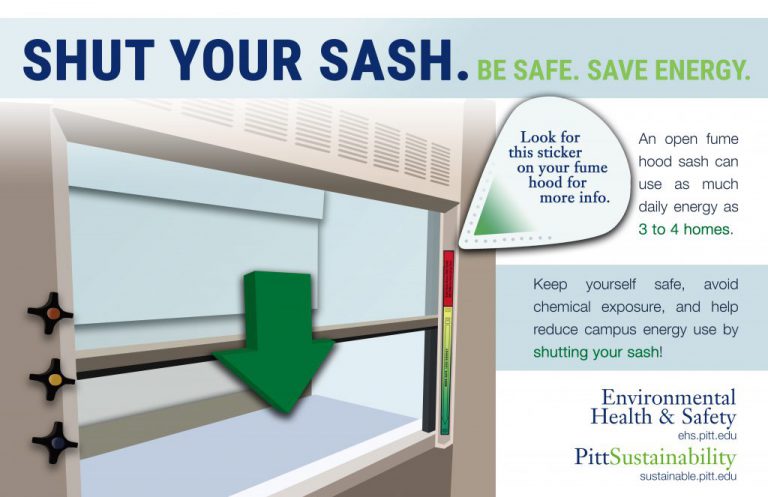
Shut the Sash

An open fume hood sash can use as much energy in a day as 3 to 4 homes! Keep yourself safe, avoid chemical exposure, and help reduce campus energy use by shutting your sash. Request your stickers today and learn more below.
What is a chemical fume hood?
Chemical fume hoods are safety devices/engineering controls that protect a user from hazardous vapors and pollutants released during experimental procedures by removing those vapors and exhausting them outside. Fume hoods confine hazardous airborne material and dilute it with large amounts of air before expelling it safely.
When should the sash be closed on a chemical fume hood?
Standard maximum operating height of sashes is ~18 inches from the base of the fume hood — or where the mechanical stop is located (if one is present). Sashes should be opened beyond 18 inches only to set up or modify an experiment. The sash should be shut whenever a user is not actively working in the fume hood to increase safety and energy savings. While some hoods in Pitt laboratories have audible alarms that remind users to shut the sash, users should remind themselves to shut the sash every time they walk away from the hood.
Where can I learn about safely operating a chemical fume hood on the University of Pittsburgh’s campus?
Pitt’s Department of Environmental Health and Safety (EH&S) has resources to help University faculty, staff, and students safely operate and maintain the fume hoods within their lab spaces. Controlling Chemical Exposures in Laboratories PDF.

What is the “Shut Your Sash” campaign and why is it important?
“Shut the Sash” was the first Pitt Green Labs initiative and is promoted by EH&S and the Office of Sustainability. The campaign seeks to educate and inform users about best practices for fume hood operation and use with a focus on reducing energy consumption.
Fume hoods can be among the most energy consuming pieces of equipment found in a typical laboratory. Because such a large volume of air is exhausted from lab spaces to the outside, a single fume hood can use as much energy as three to four residential homes in a single day. Because the exhausted air must be replaced with fresh air, energy expended both due to the operation of the fume hood’s ventilation fan and motor, but also in heating or cooling the fresh air. Proper operation of a hood’s sash has the potential to halve fume hood energy usage.
Moreover, shutting the sash protects the direct user’s health along with the health and safety of others nearby. In general, sashes help protect users from splashes, fires, and explosions.
What do the “Shut Your Sash” labels tell fume hood users?
The sash labels act as a prompt to remind laboratory workers to shut the sash when they are not actively working at the hood. They identify four key aspects for users:
Will these stickers actually work?
Only YOU can change your behavior, but U.S. Department of Energy research showed dramatic increases in safety and decreases in energy usage with reminder stickers.
Shutting your Sash not only improves the energy efficiency of the University’s lab spaces and buildings, but it is also an important safety measure. The lower the sash, the safer the conditions.
Save Energy. Be Safe. Shut Your Sash!
Shut Your Sash is just a small part of Pitt’s sustainability efforts. Click here to learn more about Pitt’s Green Lab Program.



